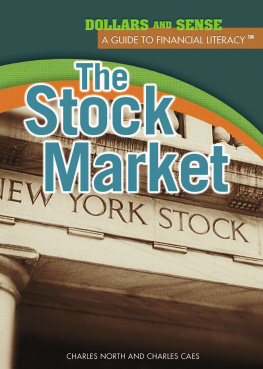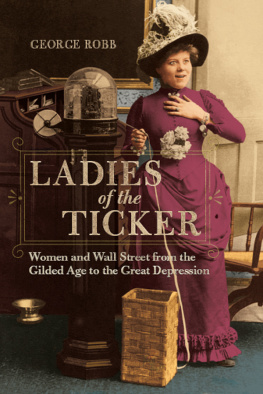HETTY
The Genius and Madness
of Americas First Female Tycoon
CHARLES SLACK

For my sisters, Jennifer Slack-Gans and Alison Slack, strong women, gentle souls

CONTENTS
At the time of her death in 1916, Hetty Green was widely regarded as the wealthiest woman in America. She left a fortune estimated conservatively at $100 million, or about $1.6 billion today. More remarkable than the sheer bulk of her fortune was the fact that she amassed the great majority of it herself, in the overwhelmingly male environs of Wall Street, at a time when women were not permitted by law to vote in an election.
She was the lone woman among a gallery of nineteenth-century rogue heroesAndrew Carnegie, Jay Gould, J. P. Morgan, John D. Rockefeller, and the Vanderbilts. She bought and sold real estate, railroads, and entire city blocks. She owned mines, and held mortgages on churches, factories, and office buildings. Major cities, including New York on more than one occasion, came to her, hat in hand, when they ran into financial trouble. She adhered all of her life to the simplest yet hardest-to-follow financial wisdom of all: She bought low, sold high, and never panicked during a panic.
Wall Street took its name from a wall erected in the 1650s by Dutch settlers at what was then the northern edge of colonial settlement on the island of Manhattan. The wall was intended to keep the British out. It failed. But as Wall Street grew into the worlds most important financial center, the wall might better have stood for the all but impenetrable barrier excluding women. In 1870, Victoria Woodhull opened the first female-owned brokerage house on Wall Street. But the brokerage, financed as a lark by Woodhulls friend Cornelius Vanderbilt, was more of a publicity stunt than a serious enterprise. Woodhull had tried her hand at newspaper publishing, running for president, and promoting the nineteenth-century religious fad of spiritualism, based on the idea that one could commune with dead relatives and friends. Wall Street was the latest venue in which Woodhull attempted to shock staid Victorian sensibilities, and the concern quickly failed. Wall Street was, in the words of historian John Steele Gordon, universally thought to be as unsuitable to women as a battlefield.
The prevailing sentiment was captured nicely in a December 1909 New York Times article about women investors. Women, it is Wall Streets conviction, are good winners but bad losers, and thats why so many brokers dislike to have women speculators among their customers, the Times stated. It is difficult to reason about money and business with an angry or weeping woman. Her view of Wall Street and all its works suddenly becomes entirely emotional, and only a broker with infinite patience can calm her. The article singled Hetty out as an exception to the rule, praising her masculine instinct for finance. She has a broader grasp of finance than many men of prominence in the Street, and her views of the values of railroads and real estate are always worth having. She makes her investments in the logical way that a man does, and she usually makes wise ones.
As the subtitle to this book indicates, there was a certain undeniable madness to Hetty. At a time when the rich were so extravagant that their spending gave the Gilded Age its name, Hetty Green had a hard time spending a quarter. People who had millions less than she did built homes on Fifth Avenue designed after the palaces of European royals whom their ancestors had crossed an ocean to escape. Hetty took public transportation back to her small flat in unfashionable Hoboken, New Jersey, or Brooklyn.
But it is also undeniable that Hettys madness, such as it was, served a vital purpose. By casting off the trappings and social expectations of her time, she freed herself to do as she pleased, to live life on terms that she and she alone determined.
Unlike Carnegie, Morgan, and Vanderbilt, who transformed their spotty reputations through philanthropy, Hetty Green left no monuments to herself. She therefore left it up to others to determine her legacyand this process has not been kind to her. In her own time, she was regarded with a roughly equal mix of admiration for her financial skills and disdain for her parsimony. In the century after her death, as the immediacy of her financial prowess receded, she slipped into obscurity, remembered (when remembered at all) as a mean old woman with too much money and too little heart.
Probably the most succinct and widely disseminated version of this portrait may be found in the Guinness Book of World Records, where Hetty is listed, along with the largest lobster, the smallest antelope, and the champion hot dog eater, as the greatest miser. She was so mean that her son had to have his leg amputated because of the delays in finding a free medical clinic, the item states. She herself lived off cold oatmeal because she was too mean to heat it, and died of apoplexy in an argument over the virtues of skimmed milk (emphasis in original).
Like most legends, this description contains kernels of truth wrapped in myth, exaggeration, and caricature. She was, indeed, extraordinarily tight with her money. Some of the things she did were shocking. She never apologized for the way she lived, and it wont do to apologize for her now. But her life eludes simple classification, and miser is a particularly unsatisfying term, for it implies a soul that is withered, dull, and desiccatedalmost devoid of life.
Hetty Green was none of these things. She was full of life, her personality if anything outsized. She was a pioneer, a trail-blazer, a woman not just of wealth but of substance. She was witty and, in her younger years, beautiful. And she never backed down from an adversary, no matter how powerful. I always try to deal justly with everyone, she once said. But if anyone wants to fight me Ill give him all the fight he wants.
NOTE : Where does Hetty Greens fortune rank among the great American fortunes? As much art as science goes into answering such questions, given imprecise estimates of wealth, the changing value of money over time, and any number of other variables. In their 1996 book, The Wealthy 100, Michael Klepper and Robert Gunther ranked the net worth of one hundred fabulously wealthy Americans by the percentage of the Gross National Product their personal fortunes represented. According to the authors, Hettys $100 million represented 1/498th of the GNP at the time of her death in 1916. Hetty, the only woman on the list, came in thirty-sixth, five places behind Microsoft founder Bill Gates, and three places ahead of current billionaire-investor Warren Buffett. John D. Rockefeller, whose $1.4 billion in 1937 represented 1/65th of the GNP, was ranked as the wealthiest American of all time.

A sleigh cut through the snowy streets of New Bedford, Massachusetts, during the early 1840s. People could not help but turn their heads as it passed. They all recognized the sleigh, the powerful black horse, and the man at the reins. Edward Mott Robinson was not a New Bedford native, but he had married into the richest whaling family in town. He had a dark, stern face with hawklike features. Black Hawk Robinson, they called him. He was known as a tough businessman, shrewd, unsentimental, thrifty, and cold. He spared little in the way of greetings to his fellow townspeople as the sleigh hurried along.
Next page











